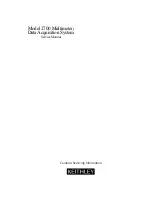
342-86400-498PS
Issue 1.2
April 2012
Page 156
Copyright
GE Multilin Inc. 2010-2012
APPENDIX A
TRAFFIC PRIORITIES
In a normal Ethernet network, there is competing traffic at each egress port of a
switch, so the provision of multiple queues is desirable to allow higher priority
traffic to be isolated from other traffic. This not only avoids reduction of the
higher-priority traffic latency, but it also avoids it being discarded during overload
scenarios.
Sources of priority include:
a) The 3-bit priority field in ingressing 802.1p and 802.1Q (Layer-2) frames.
b)
The “TOS” field in layer-3 “IP” frames.
c) A per-port user-configurable Default Priority (applicable to frames with
neither a nor b)
d) A per-port user-configurable Mapping Priority.
If a switch provides less than 8 queues, the user may be unable to provide the
correct handling of the ingressing-
frames‟ priorities (which can use any of the 8
provided by the
“tag‟s” 3-bit priority field).
Switches with 2 queues typically expect the user to set the high/low threshold
setting.
Switches with 4 queues usually ignore the least-significant bit of the 3-bit field.
Refer to Sections 2 and 5 for information on how ETHER-1000 unit supports
traffic priorities.
















































